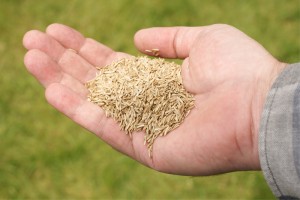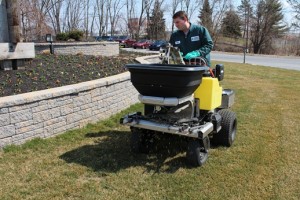 Call-in questions to our office about lawn issues provide an endless supply for lawn care blog entries. Just this week we’ve gotten a bunch of calls about one common question, “Can I seed after you put crabgrass control on my lawn?” So, this article will tackle seeding after crabgrass control, but the answer isn’t exactly simple.
Call-in questions to our office about lawn issues provide an endless supply for lawn care blog entries. Just this week we’ve gotten a bunch of calls about one common question, “Can I seed after you put crabgrass control on my lawn?” So, this article will tackle seeding after crabgrass control, but the answer isn’t exactly simple.
Why is this a problem?
In most cases the answer is “No”, but there are some exceptions. To understand the challenge of seeding your lawn after a crabgrass preventive application is applied, you must understand how crabgrass pre-emergent works. Since the thin layer of this material in the top of your lawn’s soil works well to prevent crabgrass seed germination, it also will do so for other grass seed. This means if you try to seed at any point in the early spring or immediately after a crabgrass control application, your chances of growing grass seed is virtually impossible.
What’s the solution?
However, there are some crabgrass pre-emergent weed controls that will allow for a later application in the spring. This means if you seed early enough in the spring, and then use one of these specific materials such as Dimension much later in spring, you may be successful. The challenge is that these materials are rarely available to the consumer and only offered to professional lawn care applicators. We often begin work in early spring on lawns with the first order of business of seeding the lawn. These extremely poor-quality lawns are seeded, then followed up later with a Dimension treatment. This will offer some help, but there will also need to be an aggressive approach to post-emergent crabgrass control treatments throughout the summer with a lawn care program that includes them.
What should I do now?
For these reasons, we typically recommend for most lawn owners to choose fall for the best time to seed. Not only are the temperatures getting cooler than hotter, but there aren’t any concerns about pre-emergent crabgrass control applications. There are rare instances where you may be successful seeding in the spring with a crabgrass control treatment. The way to make the seeding work is to diminish the crabgrass pre-emergent application’s effectiveness. If you have small areas that you want to seed, follow these guidelines:
- Break-up the barrier. Remember, the pre-emergent material creates a thin barrier or protection. If you chop up the soil enough, you may disturb it enough to get the new seedlings to grow. Otherwise, they’ll encounter the material before they’re mature enough and branch out. Just remember, breaking the barrier for your desired grass plants will also break the barrier for crabgrass plants to germinate as well.
- Add some clean soil. If you chop up the areas and add some soil, there will be less pre-emergent material near the seed compared to clean soil. This may help. Obviously there are areas where adding soil isn’t a good idea because it will create a mound in the grade.
- Mark the areas so they won’t be treated until the seed matures. This is particularly important if you use a lawn care service to treat the lawn. For instance, we have motorized ride-on machines which allow our applicators to treat a lawn fairly quickly. The applicator bypasses newly seeded areas until the grass is ready for herbicides, providing they’re clearly marked. It’s always a good idea to communicate with your lawn care company to make them aware of this. Likewise, letting your mowing service know about these areas can prevent damage to the small grass plants.
If there is any way you can wait until fall to seed, that’s the best option. If it’s a small area and you want to take your chances with your time, seed, and money give it a try. Just make sure everyone involved in making your lawn look its best knows what you do.


